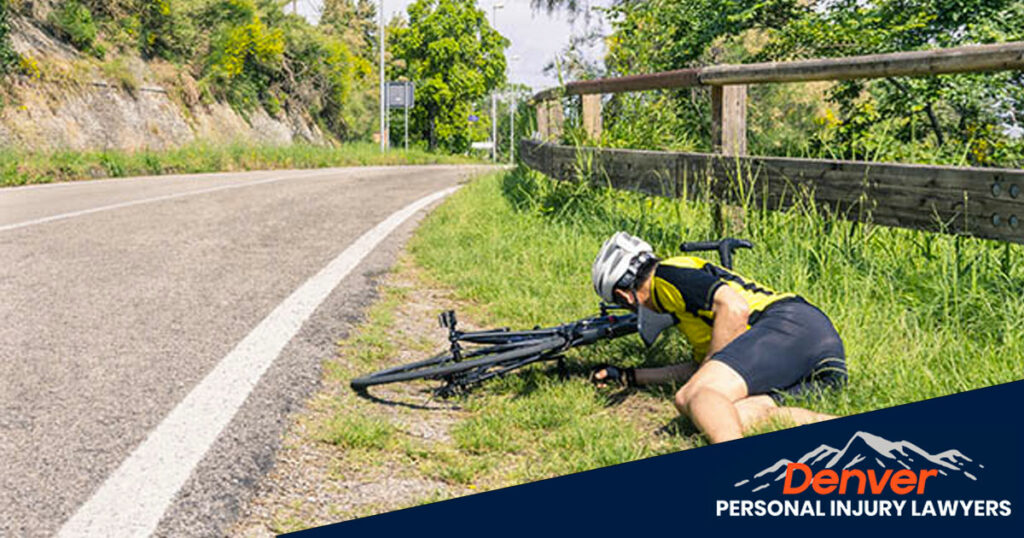Using a bicycle for exercise or transportation is common in Denver. Often we see bike accidents when motorists fail to obey traffic laws or road rules. Consequently, careless drivers cause accidents with bicyclists in Colorado.
Safety is of utmost importance when riding a bicycle. But no matter how safe or careful you are, anyone is prone to get in a bicycle accident. Cars far outnumber bicyclists in Denver. That means the odds of a bicycle or fellow rider getting in an accident with a car are higher.
Knowing what steps to take following a bike accident in Colorado can help you protect your rights. Read on to learn what to do after a bike crash.
Table of Contents
ToggleAn Overview of Bike Accidents in Denver
Many bicyclists in Denver wear helmets. However, helmets do not prevent serious injuries if a biker collides with a car. Bicyclists do not have the protective barrier like vehicles. A vehicle can weigh thousands of pounds or more. When a collision occurs even at a low speed, the consequences can be catastrophic or fatal for the bicyclist.
If you sustained injuries in a bicycle accident, you should contact an experienced Colorado bicycle accident lawyer. They can help you recover fair compensation for damages and losses incurred by the crash.
There is also a time limit to file a lawsuit against a negligent party. The time limit is known as the statute of limitations. In Colorado, the statute of limitations is three years if the accident involved a car. If something else caused the bicycle accident, the statute is only two years. If you miss the deadline, you won’t be able to file a claim for damages.
Steps to Take After a Denver Bicycle Accident
Call the Police and Wait for Them to Arrive
If no one has called the police yet, call them. Even if your injuries don’t seem serious, you’ll need a police report. Police officers can help create an objective account of the accident. In addition, police reports are critical for your case later, especially if you have injuries and need evidence for your claim.
By law, the bicyclist and the motorist should remain at the accident scene, regardless of injuries or property damage. Unless you have life-threatening or catastrophic injuries that require emergency medical attention, wait for the police to arrive. Then get medical attention as soon as you can. Often, the adrenaline of an accident masks the initial pain, so injured people don’t know the extent of their injuries until later. Also, if you leave the scene prematurely, it may be impossible to find the driver later.
Don’t Negotiate With the Motorist
The other driver may try to apologize and even accept the blame. However, refrain from negotiating with the driver. They might try to give you an offer right after the accident and change their mind or deny it ever happened. In addition, you have yet to learn the full extent of your injuries, so it’s best not to negotiate with the other driver.
Get Contact Information
Exchange contact information with the other driver. Be sure to get their name, address, phone number, license plate number, driver’s license number, the make and model of their car, and insurance policy number. It’s also important to get witness contact information.
Document Your Account of What Happened
Try to document every detail about the accident sooner rather than later. When, how, and where it happened, road conditions, weather and traffic conditions, and other details will be the clearest in your memory immediately after the accident. If you can, draw a map or diagram showing the positions and directions of you and the other car, documenting the location of any street signs or traffic signals. Use your phone to record injuries and take pictures.
Make Sure the Police Get Your Version of the Story
Sometimes police will be more concerned with getting the driver’s story than the bicyclist’s. Therefore, you must make sure to give them your statement as well. Additionally, make sure your statement is included in the police report. Be sure to report any potential injuries, despite how minor they seem. There’s always a possibility that the injury can develop into something more serious later. Lastly, remember to ask for the accident report number and write it down so you can quickly obtain it later.
Seek Immediate Medical Attention and Keep All Medical Records
No matter how minor your injuries seem, consult with a doctor immediately. Get a written evaluation of your injuries and take pictures of them. It would help if you also recorded any symptoms or signs of injury in the days following the accident.
Preserve Evidence
Take pictures of the damage to the bike and get a written estimate from a bike repair shop. It is also very important to take photos of any visible injuries that you have. Bruising, abrasions, and scars tell the story of the accident and help add value to your claim.
Refrain From Negotiating With Insurance Companies Until After You’ve Consulted With Your Attorney
The other party’s insurance may contact you and offer you money. However, unless you are trained in personal injury, there’s no way that you will know the true value of your claim. Therefore, it’s better to consult an experienced Denver bike accident lawyer before making any agreements with insurance companies.
Seek Advice From a Knowledgeable Denver Bike Accident Attorney
Seeking the professional legal counsel of a skilled Denver bike accident attorney has many advantages. They can help you with the insurance battle and an investigation and represent you in court if necessary. Remember, bicyclists have the same rights on the road as other motorists. If another driver’s negligence caused a crash and injured you, you should take the proper steps to secure fair compensation for damages.
Common Injuries in a Denver Bicycle Accident
The Colorado Department of Transportation data showed that 22 cyclists were killed in crashes in 2018. In 2021, 12 cyclists died in crashes in Colorado.
The figures in the US are significantly more prominent; hundreds of people die yearly from vehicle-related bike accidents. The National Highway Traffic Safety Administration (NHTSA) reports that cyclists account for about 2% of all traffic fatalities. What’s most alarming is that the number seems to increase every year.
Most bicycle accidents occur in the summertime and the evening when it gets darker outside. Most bike accidents occur in urban areas but sometimes in rural areas along major roads in Colorado.
Here are some of the most reported injuries following a bicycle-car collision.
- Back injuries
- Brain injuries
- Broken and fractured bones
- concussions
- Head trauma
- Paraplegia or quadriplegia
- Neck injuries
- Spinal cord injuries
- scarring
What Are the Most Common Causes of Bike Crashes in Denver, Colorado?
Drivers in Colorado must share the road with bicyclists. Likewise, bicyclists must follow the rules of the road like drivers. While bicyclists cause some accidents, most are caused by driver negligence. Here are some of the most common causes of car accidents that occur with a bike rider:
- The driver failed to yield to the bike rider’s right of way
- Heavy traffic and congestion on the roadways
- Reckless driving or aggressive driving
- Speeding
- Opening a door while a bicyclist is passing
- Distracted driving
- The driver did not see the cyclist due to poor visibility or some other distraction
- Cell phone use while driving
- Drunk driving or driving under the influence of illicit substances
- Driving while high
- Not paying attention before making a turn
Contact a Denver Bike Accident Lawyer Today
If you’ve sustained catastrophic injuries because of another party’s negligence in a bike accident, you need an experienced Denver personal injury attorney.
We represent accident victims and fight aggressively to win the complete and fair compensation they deserve.
Contact us today to schedule your free consultation.
















